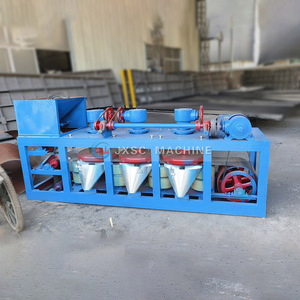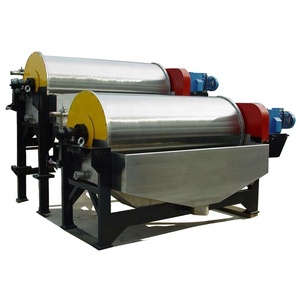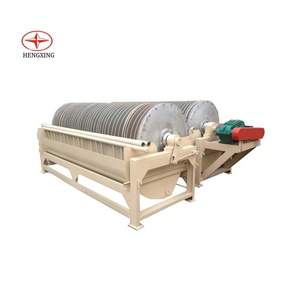(6775 products available)





























An ore magnetic separator can classify magnetic ores from others using magnetic forces. They are valuable machines that play important roles in material separation. According to the design, working principle, and available magnetic forces, separators can be divided into two primary categories and several additional subclasses.
According to the magnetic forces they provide, dry magnetic separators can be divided into strong magnetic separators and weak magnetic separators. Strong magnetic separators can attract more magnetic materials quickly, while weak magnetic ones provide gentle but sustained attraction.
Among them, high-gradient magnetic separators have stronger magnetic forces that can attract more minerals and give more precise separation. Drum separators generally have weaker magnetic forces than high-gradient ones but are more effective than dry magnetic separators. Disc separators offer more precise separation than drum ones. Inductive coil separators tend to be more specific than disc separators, only separating metallic minerals like iron and lead.
Capacity:
This refers to the amount of material the separator can process per unit of time. It is often measured in tonnes per hour (t/h) or cubic metres per hour (m3/h). The capacities of magnetic separators can differ greatly, depending on their sizes, designs and functions of the separators.
Applications:
Industrial magnetic ore separators can be found in manufacturing factories, mineral separation plants and laboratories. Different institutions require different types of separators with specific features to fulfil various purposes. Therefore, the application scope of each separator would differ. For instance, tube separators with small capacities are more often used in laboratories than in industrial settings.
Material:
Magnetic separators are usually constructed with steel, stainless steel, carbon steel, etc. The material used to make the machines not only decides the texture and lifespan of the separators but also affects the items they can handle.
Environmental factors:
The surrounding environment where a magnetic separator is situated has a significant effect on the machine too. Temperature and humidity are two crucial elements that determine whether an ore magnetic separator will function properly or not. For example, excessive humidity may lead to rusting, while extremely low or high temperature could cause thermal expansion or contraction, making the separator incompatible with ore materials.
Proper upkeep is essential for maintaining the efficiency of an ore magnetic separator. Without care, the machine may break down frequently and become inefficient in separating ore from materials.
The separator carries out periodic maintenance. Detailed equipment usage manuals generally advise routine check-ups of critical components of separators, such as bearings, belts, pulleys, gears, etc., to ensure these parts are not damaged and functioning properly. Belts are supposed to be clean and tight, while pulleys should be clean with no wear and tear. Overlaps and the gear mesh should be clean and lubricated. Electric motors should be fixed tightly to avoid any shaking that may cause misalignment of parts. Gears should be cleaned and oiled.
Any electric connections should be periodically inspected. This includes checking wires and plugs for corrosion and looseness. Corrosions should be cleaned, and loose pieces should be fastened to prevent electric leakage, shocks, or fire hazards.
It's essential to maintain a clean magnetic separator. Water can be used to rinse any residue or sand, but excess water must be removed to avoid rust and peeling paint. Cleaning residues on the belt can prevent material buildup and the belt's deviation.
Iron Ore Mining:
After the crushed minerals enter the ore magnetic separator, the magnetic system attracts and moves the iron ore to the magnetic drum, separating it from the non-magnetic particles or impurities that fall off into the waste area.
Coal Washing:
In coal washing plants, separators extract magnetic materials like iron and steel from coal to reduce contamination and improve coal quality.
Food Industry:
Food processing employs magnetic separators to remove metal contaminants, ensuring product safety and compliance.
Recycling Industry:
Magnetic separators are valuable tools for the recycling industry. They effectively sort and separate magnetic metals like iron and steel from other non-magnetic materials, such as plastics and glass, during the recycling process.
Ceramics Production:
Ore magnetic separators are utilized to remove metal contaminants from raw materials like clay and feldspar before shaping and firing. This ensures the purity and quality of the final ceramic products.
Textiles and Leather:
In the textile and leather industries, magnetic separators help remove metallic impurities from raw materials, such as fiber and hides. By doing so, they protect processing equipment and enhance the quality of the end products.
Electronics Manufacturing:
Electronics manufacturing involves employing ore magnetic separators to eliminate metal contaminants from materials used in production, such as printed circuit boards and other electronic components. This helps prevent damage to sensitive equipment and ensures product reliability.
Understand the application:
Business buyers need to understand the specific application and requirements of the ore separation process. Consider factors such as the type of ore to be processed, the particle size distribution, the desired separation efficiency, and the production capacity. This understanding will help in selecting a separator designed for specific separation needs.
Separator types:
Familiarity with various ore magnetic separator types is crucial when choosing. Drum magnetic separators are commonly used for coarse particle separation, while belt magnetic separators are suitable for handling large volumes of slurry. Disc magnetic separators are useful for fine particle separation, and crossbelt magnetic separators are effective for material on conveyor belts.
Magnetic strength:
Selecting an iron ore magnetic separator with appropriate magnetic strength is essential for achieving the desired separation results. Higher magnetic strengths attract more fine particles. Choose the separator's magnetic strength based on the specific separation requirements and the type of magnetic material to be removed.
Separator design and dimensions:
Consider the design and dimensions of the magnetic separator to ensure it fits into the existing processing infrastructure. Check the installation requirements and potential impact on processing workflow.
Maintenance and support:
When selecting an ore magnetic separator, it's crucial to think about the maintenance requirements and level of support offered by the supplier. Opt for a separator that is easy to maintain, and ensure that necessary replacement parts are readily available. Additionally, consider the technical support and expertise provided by the supplier for troubleshooting and optimisation.
Q1: What are the recent technological advancements in magnetic separators for iron ore?
A1: Recent advancements in magnetic separators for iron ore involve force optimization at the molecular level, automation of magnetic importance, and mechanical enhancement to prolong durability and reduce maintenance.
Q2: How does a magnetic separator improve product purity?
A2: A magnetic separator improves product purity by removing harmful or undesirable minerals and materials, including gangue, that may contaminate the final product.
Q3: What is the capacity of an ore magnetic separator?
A3: The capacity of an ore magnetic separator varies depending on the model and manufacturer. It is usually given in tons per hour (t/h). For instance, high-gradient magnetic separators can process 2 to 10 tons per hour, while disc magnetic separators can process up to 40 tons per hour.
Q4: How does the magnetic strength affect the separation process?
A4: The magnetic strength affects the separation process because it determines the separator's ability to attract and retain magnetic particles. Higher magnetic strength can improve the separation efficiency of weakly magnetic minerals.
Q5: What is the expected lifespan of an ore magnetic separator?
A5: The ore magnetic separator's expected lifespan ranges from 10 to 15 years, depending on factors like the quality of the materials used in manufacturing, operating conditions, maintenance practices, and the separator's design and construction quality.